Growing and caring for celery outdoors
Celery - a unique vegetable known since ancient times. It was previously thought to bring good luck and protection. And only since the 17th century. they began to eat it. All parts of the plant are used: tuberous root, succulent petioles and parsley-like tops.
We will tell you how to grow leaf, root and petiole celery in the country.
The content of the article
Types of celery
The vegetable has about 20 varieties, divided into three types. Let's analyze each subspecies separately.
Sheet
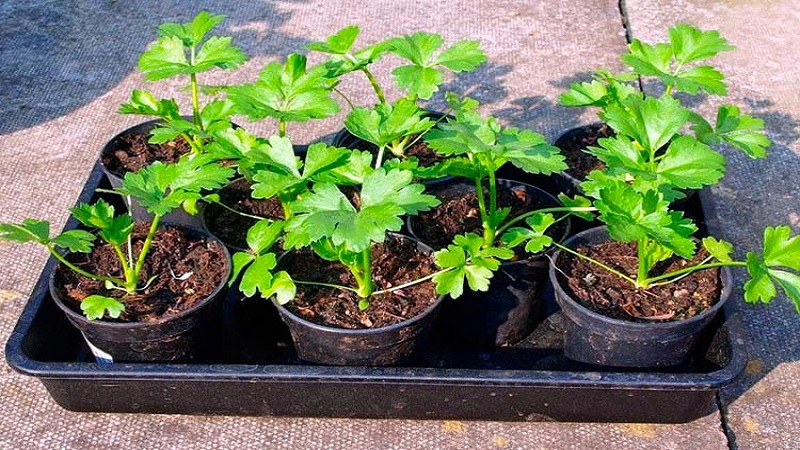
Already from the beginning of June, celery pleases with fresh and healthy herbs. It is used for making salads, added to the first and second courses, canned food, and for winter dried and frozen.
Reference. Late varieties are bred only in seedlings, the early ones are sown directly to the garden.
Root
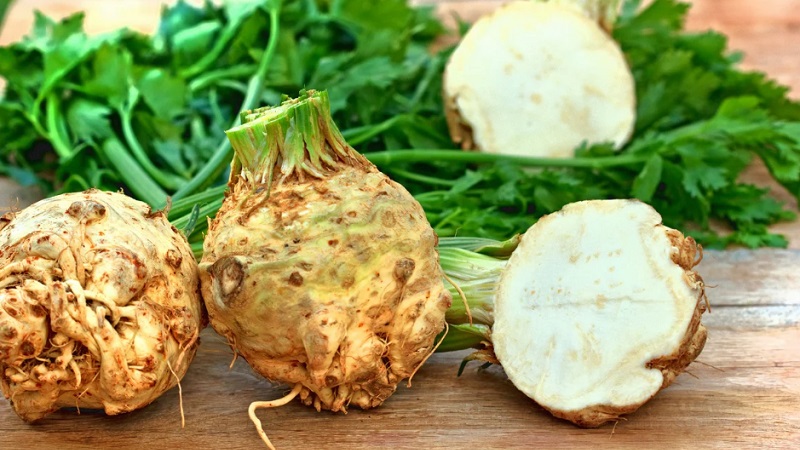
This type of celery is harvested in late autumn, almost before the first frost. However, the rounded and grown roots can be used throughout the summer. Salads are prepared from root celery.
Reference. This type of vegetable is bred exclusively with seedlings.
Petiolate
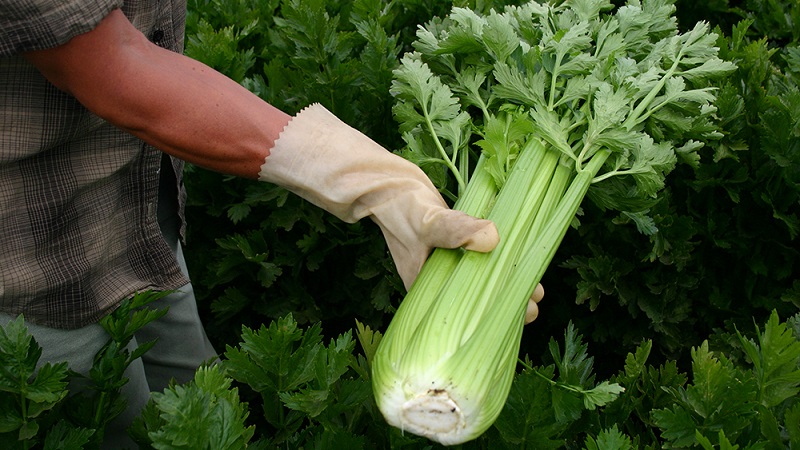
Such celery harvested at the end of summer. Salads are made from it, as from cucumbers and tomatoes. Also added to vegetable stews and soups. Store the vegetable in the refrigerator or cellar.
Reference. Like leaf celery, late celery is bred using the seedling method, and the early one is immediately planted in the beds.
Growing large celery from seeds in the open field
Since the growing season for celery lasts 120-170 days, it is grown mainly by seedlings.
How to grow seedlings at home
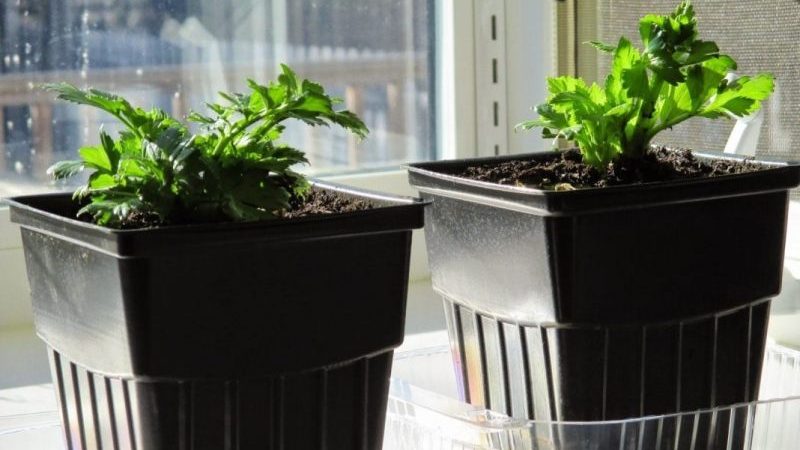
Leafy celery is planted for seedlings 56-61 days before planting, and root celery is planted 2 weeks earlier. Seedlings are transferred to open ground in early May.
Since the seeds contain essential oils that slow down the process of swelling and germination, the waiting time for shoots is delayed up to 4 weeks. To speed up the process, the seeds must be cleaned.
Several methods of bubbling are possible:
- Soak the seeds for a day in water, then place them in a 1% solution of potassium permanganate for 45 minutes. Rinse with water and dry.
- Place the seeds for 30 minutes in water heated to + 50 ... + 53 ° С, then leave them in warm water for 2 days, which must be changed 6-7 times a day. After that, spread evenly on a paper towel for further drying.
- Place seeds on damp gauze, cover with it and leave for 5-7 days.
Grow celery from last year's seeds, since they have a short germination period. After a year, their potential will significantly decrease, and in another year it will be completely zero.
As soon as the seeds have germinated, they are planted in pre-prepared containers filled with a substrate of sand and vermicompost in a 1: 1 ratio. There are several more options for the prepared sowing mixture, which is evenly distributed in the seed container and moistened. Next, shallow holes of 0.5 cm are formed at a distance of 8-10 cm.
Sprouted seeds are mixed with sand and sown in prepared grooves. From above they are sprinkled with a thin layer of sand through a sieve, covered with a film and left at a temperature of + 22 ... + 25 ° C until shoots appear, while constantly moistening the soil.
As soon as the first shoots have appeared, the temperature is lowered to + 13 ... + 16 ° С in order to avoid incorrect formation of plants.When the first leaves appear, a pick is carried out with a root clamp by 1/3. This helps root celery to form a large and rounded root crop, while petiolate and leafy ones to form a branched root system.
Open ground transplant
Celery shoots are planted in mid-May. All kinds of vegetables and nightshades can be neighbors in the garden.
Attention! You should not rush to plant seedlings, since the May coolness can provoke flowering already in the first year. As a result, neither roots nor petioles will work.
Timing
Shoots are transplanted when 4-5 leaves appear, when the stem reaches 13-15 cm, after 55-65 days from the moment the first shoots appear. Root celery should not be overexposed, otherwise the chances of getting a good harvest will decrease. A few hours before transplanting into open ground, the seedlings are watered abundantly with water so as not to damage the roots by removing them from molds or boxes.
Where to grow
The site for planting crops is prepared in the fall. The soil is well dug to a depth of 27-30 cm, abundantly fertilizing with humus (20-40 g) and mature compost (10-15 g) per 1 sq. m. The second soil preparation is carried out in early spring by deep loosening. The soil is fertilized with a part of mineral fertilizers - 5 g of potash and 10 g of phosphorus per 1 sq. m.
Reference. You can make a one-time preparation: during the pre-planting loosening, apply a complex of fertilizers (35-50 g per 1 sq. M.) - "Kemira", azofosk, nitrophoska, etc.
Landing rules and algorithm
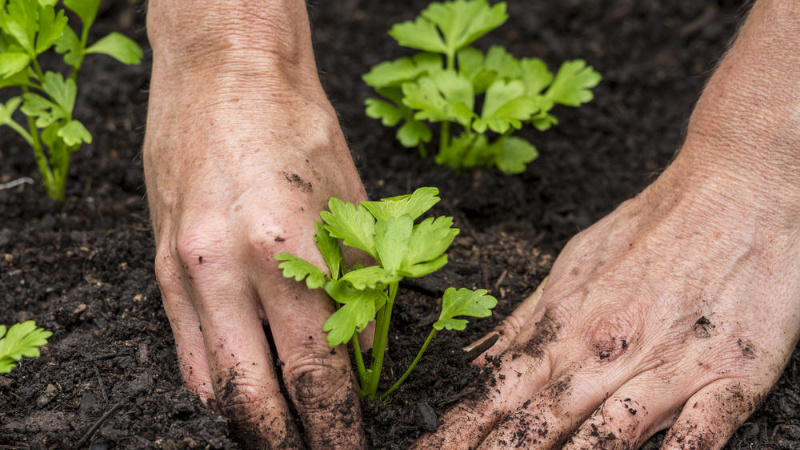
For root celery, the distance between the bushes should be 40-50 cm, as well as the gap between the rows.
When planting petiole and leaf, the distance between the bushes is 15-20 cm, and the row spacing is increased to 30 cm.
Reference.Celery is planted between rows of potatoes, garlic, onions, cabbage, cucumbers, etc.
How to grow:
- When planting, a handful of ash and humus are added to each hole, mix them well with the soil and deepen the seedlings to the point of growth.
- The soil around the seedlings is well compacted and abundant watering is performed.
- Seedlings in the early days are covered from direct sunlight with an artificial awning.
How to take care of the garden
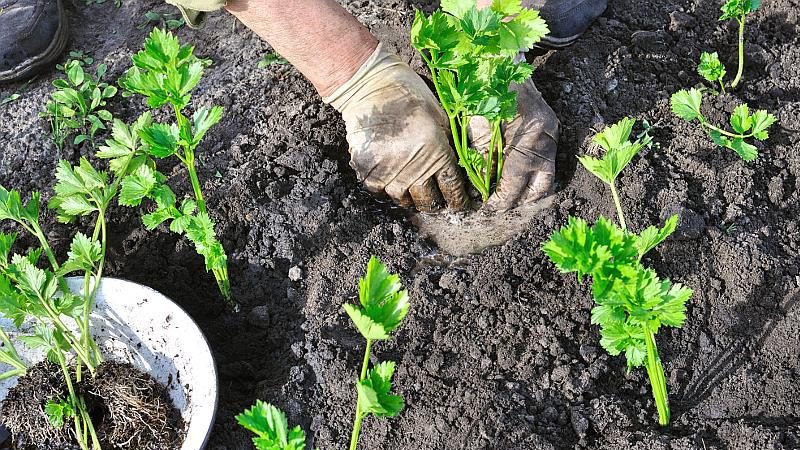
Any kind of celery requires timely watering, weeding, loosening and feeding. To avoid dehydration and saturate the roots with oxygen, after planting, the soil around the seedlings is mulched with sawdust, cut grass, and peat.
Petiolate and leafy spud 2-3 times per season, which stimulates the development of the root system. The root, on the contrary, is uncooked in order to exclude the appearance of additional roots and form a rounded fruit.
Stem celery is bleached 2-3 weeks before harvest, which helps to reduce the pungent odor and concentration of essential oils. To do this, the stems are collected and carefully wrapped in paper to prevent sunlight from entering them.
Watering and fertilizing
This culture belongs to the moisture-loving, therefore it is necessary to water it regularly, at the root. The procedure is carried out once a week at the rate of 20-25 liters of water per 1 sq. m. When drought is irrigated daily. The soil should always be slightly damp; drying out of the soil is unacceptable.
During the season, 2 dressings with a complex of organic and mineral fertilizers are quite enough. The first is produced in early June, when the plant has strengthened, the second - a month later.
Prevention of diseases and pests
Protect the plant from diseases and pests only with biological preparations. The use of chemistry is unacceptable.
Types of diseases:
- rust;
- white rot;
- bacterial rot;
- downy mildew;
- cucumber mosaic.
For preventive purposes, it is recommended to spray with biofungicides "Trichodermin", "Planriz" and "Fitosporin". In the wet and cold period, use the biological product "Fitodoctor". All these products are absolutely harmless to humans and animals.
You can avoid spraying by observing all of the above rules for seed preparation, landing and further care and cultivation.
Pests:
- borscht (celery) fly;
- carrot fly;
- bean aphid;
- whitefly;
- carrot flap.
The most effective means in the fight against the listed pests are "Lepidocide", "Boverin", "Bitoxibacillin", "Gaupsin", "Fitoverm", etc. Their combined use with biofungicides significantly increases efficiency.
Reference. In order not to lead to treatment with drugs, it is necessary to maintain cleanliness in the beds, remove weeds and plant residues in a timely manner after harvesting, and carefully dig up the soil.
What does celery look like in the garden
Celery is a biennial herb that grows up to 1 m in height and has a thickened root. In the first year of life, it forms a root crop and a rosette of pinnately dissected dark green leaves, and already in the second year the stem develops. By mid-July, white-green flowers bloom on it, forming an umbrella.
The root crop of celery has a double rounded shape with threadlike formations in each half. Three types are cultivated: leaf, petiolate (stem) and root.
Sheet
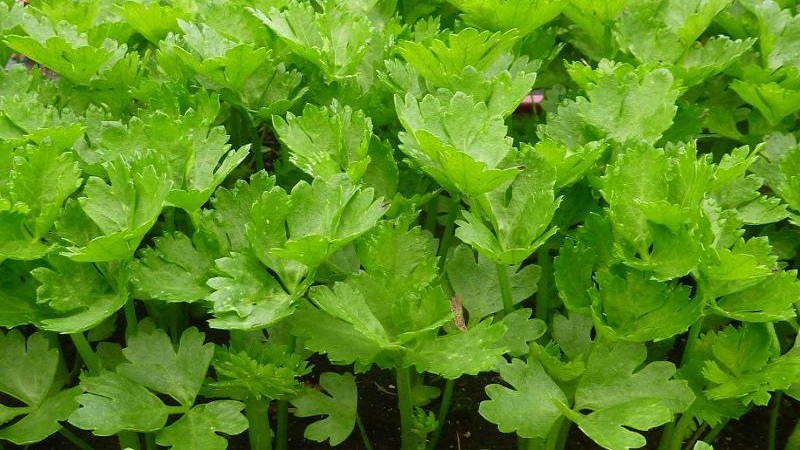
Grown to obtain juicy greens enriched with vitamins throughout the summer. It does not form a root crop. Most popular varieties:
- Zakhar;
- Tender;
- Sail;
- Samurai;
- Spartan;
- Cheerfulness;
- Cartouli.
Petiolate

This species is appreciated for its fleshy stems, the thickness of which reaches 45-50 mm. Like a leaf, the root crop is not developed. Popular varieties:
- Tango;
- Gold;
- Triumph;
- Malachite.
Root
It is grown exclusively for the sake of obtaining a root crop, reaching 450-950 g. For its medicinal qualities, it is compared to the root of ginseng. There are early, middle and late varieties.
Early:
- Cascade;
- Prague giant;
- Root Gribovsky;
- Apple;
- Diamond.
Average:
- Esaul;
- Egor;
- Strongman;
- Albin;
- Giant.
Late:
- Maxim;
- Anita.
Conclusion
Celery is an unpretentious vegetable crop. Seedlings emerge densely. To stimulate better growth and get a rich harvest, it is necessary to adhere to the agricultural technology of growing celery and the rules of caring for it in the open field.